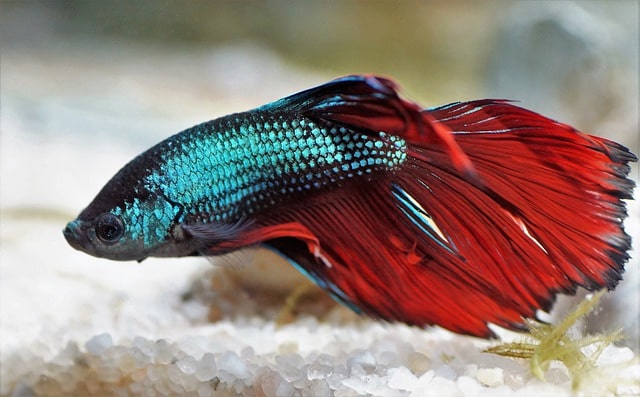What is Betta Fin Rot? Also called Tail Rot or Fins.
I first learned about it when a friend brought home a Betta fish that was acting strange. He had notice that the “tail” on his male wasn’t moving as usual and that was weird to him. I asked him how old the fish was and he said two years old. He didn’t really seem to know what to make of it.

After checking his tank to see for signs of bacterial infection, I took him to the vet. They confirmed my suspicion that Betta fin diseases were the culprit and we’re going to be treating him for them. His symptoms were quite severe, so he needed fast action to get rid of them.
His diet was changed immediately and now he has a healthy aquarium. I would have had him checked out earlier but in his case I wanted to give him time to recover from the fin rot.
Name: Fin Rot, Fin Melt, Tail Rot. scientific name: Pseudomonas fluorescens if caused from bacteria.
Cause: poor water quality or stress resulting in a weakened immune system resulting in a sick fish.
Symptoms: none. See, that was quick and simple. No need to take long hours or worry about other potential issues.
Betta fish are notorious for fin rotting, especially at the joins where the fins attach to the body. The natural way for them to attach their fins is at the juncture between the head and the caudal peduncle. That area tends to get eaten away with age and accumulates a lot of debris.
It is not uncommon for Betta fish to suffer from “Betta fin rot” even when you don’t see any signs of it. The problem is that Fin Rot is not visible to the naked eye and the condition may not be apparent until there is a full blown rot in the fins. And then, the damage is very difficult to repair.
So, how can we detect fin rot? Betta fish tend to get sick rapidly when their water quality gets below optimum levels. Tank water should not be too cloudy, there should not be a lot of sediment in the water, the nitrate levels should not be excessive, pH levels should be fine (although this can vary widely from one betta to another).
And, you should have a reasonable supply of live, dry and frozen foods. Fin rot will only manifest when all these conditions are lacking or compromised.
When you notice that some of your Betta fish are starting to suffer from “Betta fin rot”, it is time to move them to a quarantine tank. The fastest way to do this is to transfer them to a main tank that has been properly “acclimatized”. Acclimatization involves exposing the Betta fish to healthy but overstressed aquarium mates in order to encourage natural regeneration of their immune systems.
This also means that you have to make some important water changes as well. In addition to the water changes, you should quarantine the tank for a few days to let the new water settle in and for the Betta to get used to its new home.
To conclude, the best thing to do if you think your Betta fish has Betta fin rot is to quarantine the tank and treat it well until you can return it to its normal state.
Fin rot can be a potentially serious problem for Betta fish and by taking the necessary precautions before hand, you can greatly reduce the risk of any health problems occurring in your fish. You can always monitor the water quality in the main tank regularly and make any necessary water changes.
However, once you are sure that the tank is stable and the water quality is satisfactory, you should always transfer a Betta to an appropriate tank that has been properly acclimatized.
